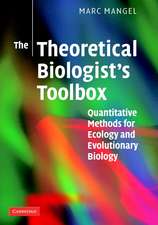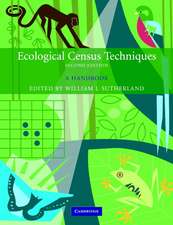Autecology: Organisms, Interactions and Environmental Dynamics
Autor Gimme H. Walter, Rob Hengevelden Limba Engleză Hardback – 24 apr 2014
Preț: 1339.62 lei
Preț vechi: 1633.68 lei
-18% Nou
Puncte Express: 2009
Preț estimativ în valută:
256.37€ • 266.66$ • 211.65£
256.37€ • 266.66$ • 211.65£
Carte tipărită la comandă
Livrare economică 12-26 aprilie
Preluare comenzi: 021 569.72.76
Specificații
ISBN-13: 9781482214147
ISBN-10: 1482214148
Pagini: 484
Ilustrații: 94 black & white illustrations
Dimensiuni: 156 x 234 x 30 mm
Greutate: 0.82 kg
Ediția:New.
Editura: CRC Press
Colecția CRC Press
Locul publicării:Boca Raton, United States
ISBN-10: 1482214148
Pagini: 484
Ilustrații: 94 black & white illustrations
Dimensiuni: 156 x 234 x 30 mm
Greutate: 0.82 kg
Ediția:New.
Editura: CRC Press
Colecția CRC Press
Locul publicării:Boca Raton, United States
Cuprins
Preface, Chapter 1. Introduction—An Outline and Justification for Autecology, Chapter 2. Two Alternative Approaches in Ecology, Chapter 3. Basic Ecological Processes and the Autecological Generalization, Chapter 4. Spatio-Temporal Dynamics—Climatic Variables and the Response Rates of Organisms, Chapter 5. Environmental Matching—Individuals, Species and Scales in Ecology, Chapter 6. Environmental Response Systems of Organisms— Determinants of Spatio-Temporal Dynamics, Chapter 7. Quantifying Autecology — Survival, Reproduction and Movement, Chapter 8. Research in Ecology—Patterns and the Scientific Exploration and Reconstruction of Ecological Processes, Chapter 9. Organisms Across Space and Over Time—Deterministic Structures, Stochastic Influences, Environmental Gradients and Risk Analysis, Chapter 10. Contrasting the Ecological Paradigms—Principles, Related Sub-Disciplines, General Laws and Prediction, Appendix, Glossary, References, Index
Descriere
This book spells out the theoretical structure, methodology and philosophy of the science of autecology. The autecological approach focuses on the interactions of individual organisms (and their species-specific adaptations) with the spatio-temporal dynamics of their environment as a basis for interpreting patterns of diversity and abundance in natural systems. This organism-based approach to ecological interpretation provides a strong alternative to more traditional approaches and relates mechanistically to the underlying disciplines of anatomy, physiology, and behavior. The book includes illustrations, specific examples, graphs, maps, and other diagrams.
















